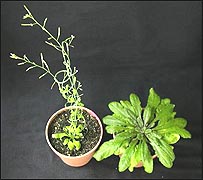
This page was produced as part of an undergraduate seminar at Davidson College.
The Popular Press- "Super Cabbage"
The Korea Times coined the term "Super Cabbage" with their article in January of 2004 in which they presented an exaggerated but more or less accurate portrayal of what had been discovered (Tae-gyu, 2004). Scientists led by Dr. Kim Jungmook at Chonnan National University discovered the gene ACG1 through repeated genetic testing of Arabidopsis (Tae-gyu, 2004). The Korea Times states that the gene is associated with both cold tolerance proteins and the repression of FLC (Tae-gyu, 2004). Manipulation of the ACG1 gene was found to increase expression of cold-tolerant proteins as well as cause a dramatic increase in Arabidopsis leaf size (Tae-gyu, 2004). The reason these findings are significant is that cabbage is in the mustard family along with Arabidopsis, as noted previously (TAIR, 2004). Their findings would easily translate to the same manipulation in this crucial cabbage cash crop (Tae-gyu, 2004). It is easy to see, then, why the popular press made such a fuss, although a transgenic cabbage with this mutation has yet to be created.

An image of the gross difference between "Super Arabidopsis" on the right and regular Arabidopsis on the left. (Tae-gyu, 2004)
*Permission Pending*
But what is really going on here?
Well, the Hyoun-Joung research group was led to the ACG1 mutation through targeted genetic analysis of a complex called CBF/DREB, part of a little understood cold-tolerance pathway (Hyoun-Joung, 2004). Mutation of the ACG1 gene created a null allele in the autonomous gene pathway, having a direct effect on FVE (Hyoun-Joung, 2004). The group theorizes that FVE is used by the plant to detect low temperatures in the environment and subsequently lower its levels of FLC as is appropriate under the influence of vernalization (Hyoun-Joung, 2004). Further theory was brought to light by the Ausin group with their discovery of the interaction between FVE and FLC being largely based on acetylation, as previously discussed (Ausin, 2004). The effect of the autonomous gene pathway being disabled is, of course, heightened levels of FLC (Amasino, 2003). Remember from the previous topic that heightened levels of FLC lead to a stasis of the Arabidopsis in a vegetative stage (Amasino, 2003). This stasis would cause the leaves to grow dramatically large and for flowering to be postponed indefinitely. In Arabidopsis, this simply means that the leaves will be larger and that the weed will be cold-tolerant. However, if this mutation was reliably applied to cabbage then the effects would be highly beneficial. We would see increased levels of cold-tolerant proteins in the cabbage that would enable them to deal with harsh climates (Tae-Gyu, 2004). We would also see grossly larger edible cabbage leaves due to the stasis of the plant in the vegetative state (Tae-gyu, 2004). Being able to delay the flowering of a cabbage is something for which every farmer hopes. This is because after a cabbage flowers, it stops leaf growth. One can then see the economic importance of this gene, a means by which to make gold mines out of mere bronze. A reiteration of these points can be seen in the cartoon below.

Cartoon Image of the disabling of the Autonomous Gene Pathway as described above (Amasino, 2003). *Permission Pending*
1) Note that in this case, the LD protein has become the null allele and has caused the rest of the autonomous pathway to malfunction (Hyoun-Joung, 2004).
2) The autonomous pathway absent, there is no down-regulation of the FLC protein (Hyoun-Joung, 2004).
3) The FLC hovers in stasis and causes the plant to stay vegetative (Amasino, 2003).
Conclusion
Here we see one of the many instances in which science has carried the most basic of information from the most publicly obscure of platforms (a weed, in fact) to create an opportunity for the common good. Understanding the stages of these elaborate discoveries, right down to their humble roots, is truly part of the full actualization of science and will enable the scientific community to advance itself far. "Super Cabbage" may join the ranks of Bt Corn and Round-Up Ready Soybean as the newest innovation in Genetically Modified Crops, perhaps one day becoming a staple of agricultural technology. Only time will tell as more is learned about genetic modification and its implications for both humans and the balance of the natural world.
Return to the Genetically Modified Organisms Seminar Homepage
Return to the Biology Department at Davidson College
Return to the Davidson College Homepage
Questions? Comments? Suggestions? Email Matt Talbert ('05) by clicking here.